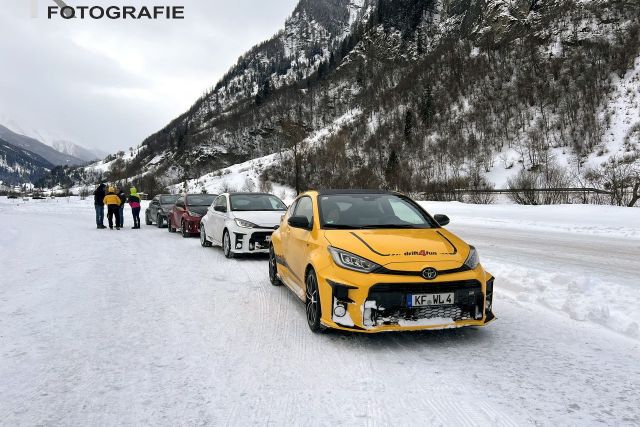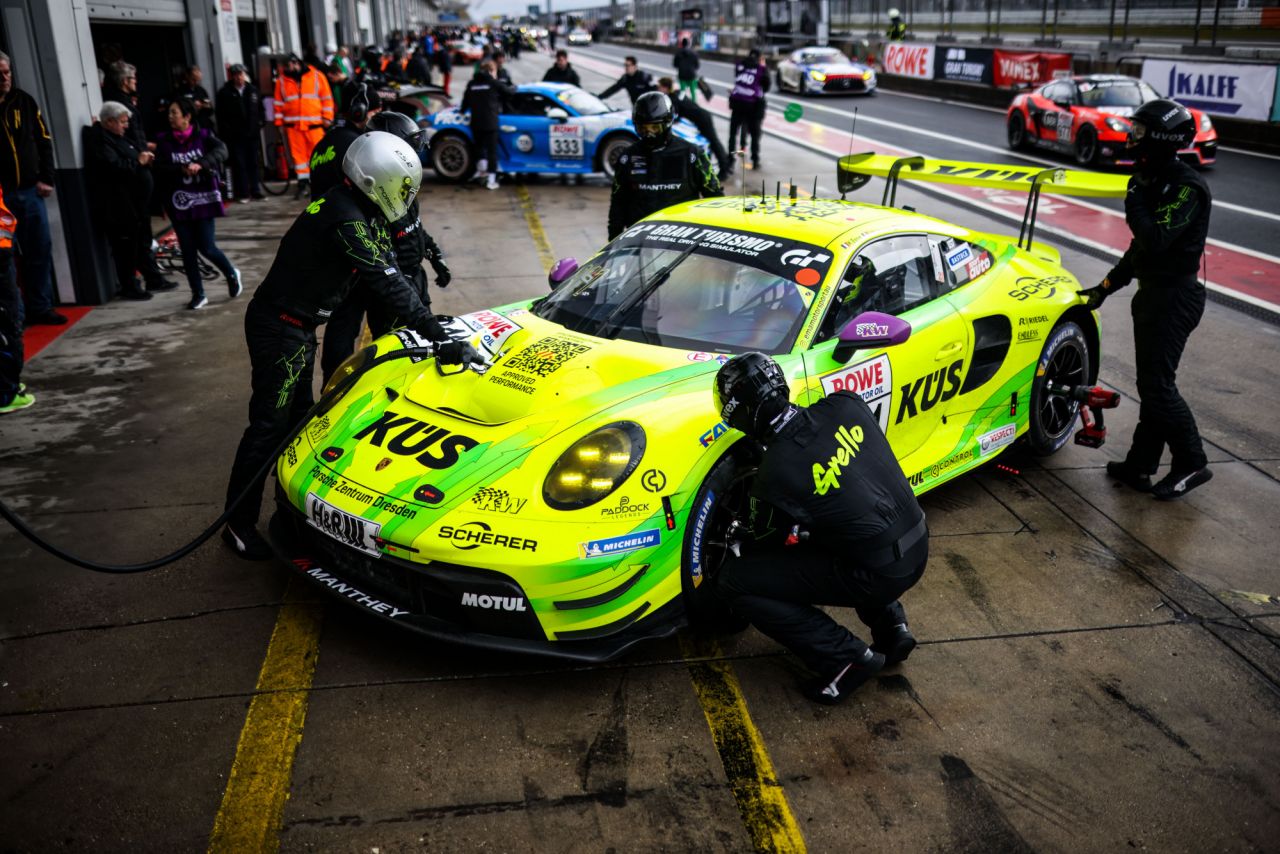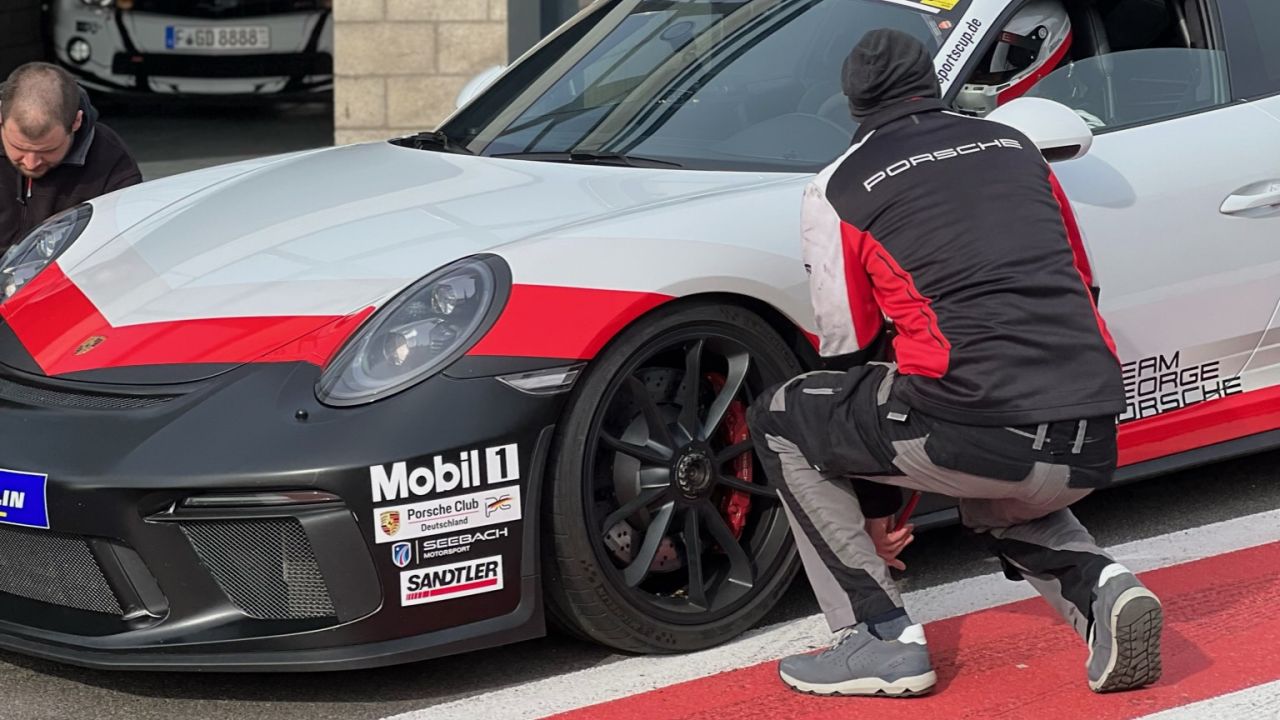Driving rules
At the Pistenclub we do not drive against each other, but with each other. For this reason, it is important that all participants abide by our rules. These are not only for safety, but also ensure a smooth course of events and thus more riding time for all participants.
Whether it's overtaking other participants, compulsory helmets or flag signals: the driving rules and the associated safety rules must be observed at all costs. At all events, the Pistenclub relies on trained staff to ensure compliance with these rules.
In this article we have summarised the most important information for you.
By participating in our events you accept our driving rules. Failure to comply with the rules stated here may result in a warning or exclusion from the event.
Driver and passenger
Mandatory helmet
At all trackdays of the Pistenclub, without exception, helmets are compulsory for drivers and co-drivers as soon as and as long as the vehicle is moving in the pit lane and on the track. We recommend a motorsport helmet in accordance with the current FIA regulations - but an intact motorbike helmet is also permitted.
In open vehicles, the driver and passenger must wear a helmet.
In open vehicles a closed full-face helmet is mandatory, in closed vehicles you may also wear an open jet helmet.
Driver and passenger ribbons
Your driver's wristband, which you will receive at the end of the briefing, must be shown at the end of the pit lane each time you drive on the track. The same applies to your co-drivers. Put it on your wrist so tightly that you cannot remove it without destroying it. Passing on a driver or co-driver wristband will result in immediate exclusion from the event.
Vehicle occupants
A maximum of two people are allowed in the vehicle. Anyone with an appropriate driving licence or a valid racing licence may take part. For the group of registered vehicles, the following applies: driving licence. For the group of non-approved vehicles, the following applies: driving licence or valid racing licence. The minimum age for drivers is 18 years. The minimum age for co-drivers is always 16 years. In France, Italy and on the Nordschleife 18 years.
Clothing
On all circuits in Italy and France, fireproof clothing (overalls, gloves and shoes) is mandatory for all participants with non-road-legal vehicles.
Driving regulations
General
Important note on our trackdays and on the subject of driving regulations:
- Our trackdays are NOT about achieving top speeds, but about improving personal skills.
- This also includes practising and practising safe and collegial interaction. This includes safely managing overtaking situations of faster and slower riders.
- This is not about driving regulations of the FIA or the DMSB.
- This is about the Pistenclub driving regulations for our trackdays/driving trainings.
- So please read well and understand the differences.
- There may be a lot of money at stake.
- There is no waiver of liability between each other. The person who caused the accident is liable/pays not only for his damage, but also for the damage of the injured party and that to the track.
- Our driving rules are about achieving maximum safety for all participants.
- Different rules apply at racing events or test drives, where the aim is to achieve maximum performance.
Pit lane
- Speed limit in the pit lane: 60 km/h (unless otherwise specified on site).
- Turning (driving against the direction of travel) and reversing in the pit lane is strictly prohibited.
Pit lane exit
- Access to the track is ONLY permitted via the pit lane EXIT.
- The white line after the pit lane exit is in most cases very long and must not be crossed, not even touched, by competitors exiting the pit lane. Ideally, you even leave enough space to the white line and drive in the middle at most. Driving onto the track involves a not inconsiderable risk. The white line may be crossed by competitors already driving on the track as such, and at many tracks the ideal line runs "over" the white line (e.g. Nürburgring) or just past it (e.g. Hockenheim).
- So: Do not drive over the white line and even after the end of the white line be careful not to endanger yourself or other participants. So be very attentive, use the mirrors very early and sustainably, and carefully "enter the traffic" to avoid a collision.
- A particular danger is that other vehicles travelling on a normal lap will at some point be parallel to the vehicle entering the track and will be in the blind spot for the oncoming vehicle. It is even more critical when two competitors who are on the track overtake each other in this area.
- Therefore: extreme caution when driving onto the track.
- When you are in the pit lane exit, accelerate carefully and remember not to do so too hard while there is still steering angle. But also afterwards, when going straight, be careful when accelerating with cold tyres.
Pit lane entry
- The track may only be exited through the pit lane ENTRANCE.
- Leaving the track involves a not inconsiderable risk.
- Leaving the track through the pit lane ENTRY must be indicated at least one turn in advance by flashing the indicators. The vehicle may only be driven on the edge of the lane on the pit side until it has left the track. Otherwise, there is a great risk of misunderstandings and a considerable risk of accidents.
General behaviour
- On the entire route, incl. hard shoulder, there is an absolute ban on stopping, except for technical defects.
- Turning (driving against the direction of travel) and reversing on the track is strictly prohibited.
- It is imperative to adapt one's own speed to the road, visibility and weather conditions, as well as to one's personal abilities and the characteristics of the vehicle.
- 1st lap of a session should absolutely be an information lap.
- Do not drive unnecessarily slow, erratically or in any other way that could be considered dangerous.
- We assume mutual consideration!
- Competition with racing character is expressly prohibited!
- Security and rescue vehicles (in motion) on the track with the signalling system switched on may not be overtaken, unless otherwise indicated.
- If you return to the track after a ride in the gravel, first stay at the edge of the track so as not to spread the gravel on the racing line. Drive into the pits and remove all gravel from your vehicle. Only then is a further drive permitted.
Behaviour in wet track conditions
- Please take extra care in wet track conditions.
- Also pay attention to where you have more grip.
- Often it makes sense to drive a rain line.
- Please also pay attention to pad changes.
- The grip level differs sometimes considerably.
- Stay away from the curbs.
- Switches on the low beam.
Behaviour in the event of loss of operating resources
- Check rear traffic.
- While observing the traffic behind, leave the ideal line as quickly as possible, using the indicator correctly, and stop safely.
- Once you have come to a stop: switch on the hazard warning lights, whether you have broken down on the track or on the hard shoulder.
- Use a parking space if possible. Of course, never make a U-turn, but drive past the parking pocket and reverse into it. In this very special case, the short reverse is exceptionally OK. If there is a sports attendant there, please instruct him/her.
- The track safety will send a recovery vehicle on its way. Self-organised towing or recovery operations are strictly prohibited.
Behaviour in case of: The vehicle is still roadworthy in the event of a technical defect or after an accident:
- Check rear traffic.
- While observing the traffic behind, leave the racing line as quickly as possible, using the indicator correctly, and stop safely.
- Once you have come to a stop: switch on the hazard warning lights, whether you have broken down on the track or on the hard shoulder.
- Use a parking space if possible. Of course, never make a U-turn, but drive past the parking pocket and reverse into it. In this very special case, the short reverse is exceptionally OK. If there is a sports attendant there, please instruct him/her.
- The track safety will send a recovery vehicle on its way. Self-organised towing or recovery operations are strictly prohibited.
Behaviour in the event of a major accident: the vehicle is no longer manoeuvrable:
- Keep your seat belt fastened, check rear traffic, and depending on your personal condition and the overall situation (Where did I come to a stop? How great is the risk from following vehicles if I get out of the car now? etc.), I decide whether to remain seated with my seat belt fastened or to get out of the car and look for a safe place behind the crash barriers as quickly as possible.
- If you cannot leave the vehicle without risk in order to get to safety behind a crash barrier, you are often relatively well off in the vehicle even if you are wearing a seat belt. Because if you come to a halt on the track unable to manoeuvre, an appropriate flag signal is shown wherever possible and a recovery vehicle is sent on its way.
- The track safety sends a recovery vehicle on its way. Self-organised towing or recovery operations are strictly prohibited.
Rules on overtaking
There is no waiver of liability between each other. The person who caused the accident is liable/pays not only for his damage, but also for the damage of the injured party and that to the track.
So it is quickly very, very expensive, especially if the insurance does not pay or there is none, as in the group of unregistered vehicles. And no comprehensive insurance for non-road-legal vehicles or racing vehicles will help there.
The damage to the injured party and the damage to the track will not be paid for in any case by a hull insurance that may exist.
Overtaking: left and right permitted.
The following rules must be observed:
- Permanent (!!!) observation of the traffic BEFORE, BEHIND and BEHIND you. Permanently (!!!)
- If someone runs up, it is almost always because they are faster. So the situation needs to be resolved quickly so that BOTH can drive freely again.
How?
- The slower one stays on the ideal line.
- He flashes (e.g. in Hockenheim on the start-finish straight on the left) early with the side he stays on, or he flashes to the side he is going to (e.g. after the entrance Motodrom on the right, because there is the ideal line to the braking point of the Sachskurve). This allows the faster rider to overtake on the inside before the next bend. In order for this to be completed before the bend, it naturally makes sense for the slower rider to signal early. This way, the faster rider recognises the slower rider's intention and can act accordingly. The overtaking process is thus shortened.
- It is best for the slower rider to support this, if necessary, by not braking as late as he might be able to, but "surfing" to the braking point. This also shortens the overtaking process, just like the correct flashing of the lights.
The overtaking process must be completed before the bend. Ideally, well before the bend. Specifically: The overtaking driver must have passed the front of the overtaken vehicle with his own rear at the point where the overtaken driver has his turning point (i.e. the overtaking process must have been completed).
The point is that the overtaking vehicle must be clearly visible to the one being overtaken, so that he does not steer into it.
Remember that in such a case, the person overtaking is at fault and must not only answer for his damage, but also for the damage to the other person and to the track.
The only exception is if the slower rider signals with a clear flashing signal that he wants to be overtaken, e.g. on the inside, while still turning or cornering. If later, in the event that he does turn in, you cannot prove this with your own camera images, you still have a problem. Therefore, think about whether you want to overtake.
In summary:
- The slower one stays on the ideal line.
- The slower one signals early.
- He who signals left stays on the left or drives to the left.
- Whoever signals right stays right or drives to the right.
- The slower one takes speed out.
- Overtaking can also be done without signalling, but it helps immensely.
- Overtaking with 3 cars side by side usually does not go well. So refrain from doing so!
- Please bear in mind that the person overtaking may endanger himself and the person being overtaken if he drives in front of the vehicle after overtaking. In almost all cases, it is better if the overtaker maintains his line of travel (his "lane") after overtaking, brakes on this line and also turns in from there.
- The overriding maxim is that the slower rider does not drive away from his line and thereby ensures that he does not cross the ideal line. He stays on the ideal line. If he decides that he still wants to be overtaken on the turn-in or afterwards, he turns in a little later at the most, or drives a slightly wider line. But even then he does not cross the ideal line. In almost all cases, the faster rider overtakes him on the inside. We recommend, however, that the faster rider does not signal to the slower rider to overtake him when turning in or afterwards. If the slower rider does not signal, the overtaking process must be completed before the turn is made, otherwise it must be aborted.
- By driving the slower one on the ideal line, almost all overtaking manoeuvres take place in such a way that the faster one can overtake on the inside on the way to the next bend and everything is simple and manageable.
There are only 2 exceptions, but even there the maxim is that the slower rider rides on the ideal line:
Extra long corners of many hundreds of metres in length (e.g. Parabolika / Hockenheimring):
Here the racing line is on the inside. That's why the faster drivers overtake on the outside. Whereas the outside becomes the inside anyway in the course of the Parabolika and before the hairpin.
The ideal line here is on the inside.
A right-hand bend is followed by a left-hand bend or vice versa:
Therefore, the ideal line for the vehicle in front is from the deflection point of the right-hand bend on the left-hand side of the track to the braking point of the left-hand bend on the right-hand side of the track. The slower vehicle will therefore drive on the straight between the two curves from the left-hand side of the track to the right-hand side of the track. This is its ideal line. Here, the faster one will please wait until the slower one has sorted itself out.
In this manoeuvre, the slower rider ideally signals early, continues on the ideal line, i.e. to the right, and supports the overtaking manoeuvre by only going so fast that the overtaking process is easy and quick.
"Analogous but the other way round" when a left-hand bend is followed by a right-hand bend:
Let the slower one drive the ideal line and wait until he, driving on it, has changed the side of the track.
The core of this rule is that you let the slower one drive on the ideal line and wait until you overtake on the straight and before the next curve on the inner side.
The risk of collision if the oncoming car does not let the slower one change sides of the track is that the slower one steers into the overtaking one while the latter tries to overtake on the side where the slower one - following the racing line - wants to go.
High horsepower cars with drivers who still have potential ;-)
The driving rules of the piste club state clearly: If someone runs aground, the situation must be resolved swiftly so that BOTH can drive freely again.
The car in front (even if it has 400 hp more!!!) can be as fast as it wants to go straight ahead, the car in front will be let by at the earliest opportunity, ideally when going straight ahead before the next bend, as described here in detail. Only accelerate moderately early on if someone has run into you. And DO NOT accelerate normally, because then the problems are pre-programmed.
In summary:
- The slower one stays on the ideal line.
- The slower one signals early.
- He who signals left stays left or drives to the left.
- He who signals right stays right or drives to the right.
- The slower one takes speed out.
 EN
EN  DE
DE  IT
IT  FR
FR 




